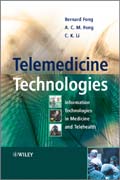
Telemedicine technologies: information technologies in medicine and telehealth
Fong, Bernard
Fong, A.C.M.
Li, C.K.
Wireless Telemedicine: Information Technologies in Medicine focuses on how medical information can be reliably transmitted through wireless communication networks. It explains how they can be optimized to carry medical information invarious situations by utilizing readily available traditional wireless local area network (WLAN) and broadband wireless access (BWA) systems. This book addresses topics such as communication networks and services, patient monitoring,information processing, system deployment, data security and privacy, information technology in alternative medicine, multimedia and health informatics, and caring for the community. * Focuses on the transmission of medical information over wireless communication networks, and addresses topics such as communication networks and services, patient monitoring, information processing, system deployment, data security and privacy, and many others * Provides an in-depth introduction to the various factors that need to be considered for supporting healthcare services with information technology * Covers advancements in topics such as RFID in healthcare * Discusses medical signal processing as well as ECG and signal processing techniques * Includes an accompanying website containing PowerPoint slides, technical questions and solutions for teaching/learning purposes INDICE: Preface Chapter 1 Introduction 1.1 Information Technology and Healthcare Professionals 1.2 Providing Healthcare to Patients 1.3 Health Informatics Developments 1.4 Different Definition of Telemedicine 1.5 Overview on Telemedicine 1.6 The Growth of The Internet: Information Flooding in E-Health Chapter 2 Communication Networks and Services 2.1 Wireless Communications Basics 2.2 Types of Wireless Networks 2.3 M-Health and Telemedicine Applications 2.4 The Outdoor Operating Environment 2.5 RFID in Healthcare Chapter 3 Wireless Technology in Patient Rescue and Monitoring 3.1 Body Area Network 3.2 Emergency Rescue 3.3 Remote Recovery 3.4 At the Hospital 3.5 General Health Assessments Chapter 4 Technologies in Medical Information Processing 4.1 Collecting Data from Patients 4.2 Bio-signal Transmission and Processing 4.3 Patient Records and Data Mining Applications 4.4 Knowledge Management for Clinical Applications 4.5 Electronic Drug Store Chapter 5 Wireless Telemedicine System Deployment 5.1 Planning and Deployment Considerations 5.2 Scalability to Support Future Growth 5.3 Integration with Existing IT Infrastructure 5.4 Evaluating IT Service and Solution Provider 5.5 Quality Measurement Chapter 6 Technologies for Safeguarding Medical Data and Privacy 6.1 Information Security Overview 6.2 Cryptography 6.3 Safeguarding Patient Medical History 6.4 Anonymous Data Collection andProcessing 6.5 Biometric Security and Identification Chapter 7 Information Technology in Alternative Medicine 7.1 Technology for Natural Healing and Preventive Care 7.2 Interactive Gaming for Healthcare 7.3 Consumer Electronics in Healthcare 7.4 Telehealth in General Healthcare and Fitness Chapter 8 Caring forthe Community 8.1 Telecare 8.2 Safeguarding the elderly and the ageing population 8.3 Telemedicine in Physiotherapy 8.4 Healthcare Access for Rural Areas 8.5 Healthcare Technology and the Environment Chapter 9 Future Trends in Healthcare Technology 9.1 Prognostics in Telemedicine 9.2 The Aging Population: HomeCare for the Elderly 9.3 Clothing Technology and Healthcare 9.4 Haptic Sensing for Practitioners 9.5 The Future of Telemedicine and Information Technology for Everyone: From Newborn to Becoming a Medical Professional all the way through to Retirement Appendix Key features of major wireless network types
- ISBN: 978-0-470-74569-4
- Editorial: John Wiley & Sons
- Encuadernacion: Cartoné
- Páginas: 288
- Fecha Publicación: 22/10/2010
- Nº Volúmenes: 1
- Idioma: Inglés
